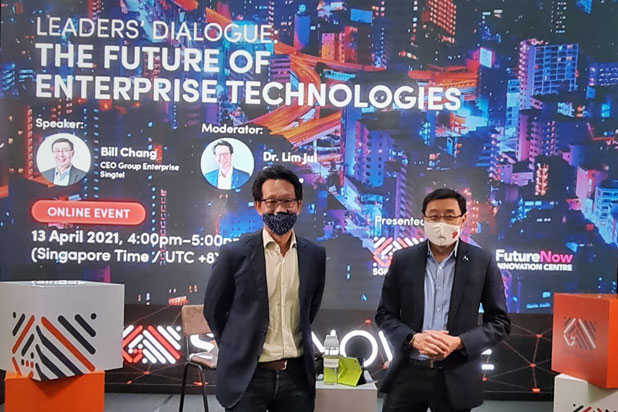3 ICT technologies shaping the future of digital businesses
Wed, 05/19/2021 - 12:00
A significant area of COVID-19-led business transformation was the complete upending of the traditional office-based employee experience, which made many businesses relook the way they operate and serve their customers. As Singapore and the rest of the world look ahead and tap on post-pandemic growth opportunities, there is a growing consensus that this rapid digitalisation and workplace transformation has the potential to positively impact both internal and external stakeholders in the long run.
In his recent Singapore Budget 2021 speech, Deputy Prime Minister (DPM) Heng Swee Keat announced that over S$24 billion would be allocated over the next three years to help businesses and workers transition to a post-pandemic world, of which a significant budget is allocated to enable businesses to adopt digital solutions and technological improvements. This includes the Emerging Technology Programme that will share the costs of testing and adopting new technologies like 5G and Artificial Intelligence (AI). These technologies have a tremendous influence on the way we access, store, and utilise information, keeping teams safe and enabling them to work more efficiently while removing the obstacles to innovation and collaboration.

[Left to Right] Dr Lim Jui, CEO, SGInnovate; Bill Chang, CEO Group Enterprise, Singtel.
This “hybridisation” of work and business is here to stay, said Bill Chang, CEO Group Enterprise of Singtel. Speaking to CEO of SGInnovate Dr Lim Jui during a dialogue presented by SGInnovate and Singtel FutureNow Innovation Centre, Chang identified three enterprise technology areas that will define the future of work for enterprises and startups alike.
1. Data analytics
Data analytics has traditionally been the exclusive territory of the larger enterprises due to the scale and resources involved in rolling out such initiatives. However, the advent of Cloud Tech and AI have helped level the playing field when it comes to the adoption of data analytics, said Chang. Cloud-based delivery models such as Software-as-a-Service (SaaS) and Machine-Learning-as-a-Service (MLaaS) could allow small businesses to use the same analytics capabilities that large enterprises have at a fraction of the cost.
Despite the availability of these new tools, SMEs still have some way to catch up in their adoption of data analytics and AI solutions. A 2020 study by the Singapore Institute of Technology, RSM Singapore and the Institute of Singapore Chartered Accountants found that 70 per cent of SMEs have yet to adopt data analytics. OECD notes that this SME gap is a global challenge, citing the lack of data culture, lack of awareness on what AI could bring, and the costs that go with retraining staff and other complementary investments as some barriers to adoption.
It is important to educate companies of the benefits of AI, which OECD sums up as two interrelated dynamics: “by altering their business environment and easing the conditions under which they do business, or by enabling them to change their business models and practices, which could ultimately allow them to increase productivity and outreach, and scale-up.”
Chang shared that Singtel’s in-house data analytics subsidiary has been able to help retailers gain more robust shopper’s insights by analysing footfall behaviour alongside transactional data and real-time social media sentiment analysis. As brick-and-mortar business models become omnichannel ones, the ability to gain granular insights into online activities and real-world events is becoming essential for businesses — as giants FAANG (Facebook, Apple, Amazon, Netflix, and Google/Alphabet) have proven.
2. 5G
Fifth-generation (5G) mobile networks are a hotly anticipated technology in the consumer and enterprise sectors. “5G will turbocharge the whole Internet of Things (IoT) plane and bring about things that are not possible today with current technologies,” said Chang.
The major transformative impact of high-capacity, low-latency 5G broadband networks are their ability to run data-intensive applications like autonomous robotics, drones, and vehicles at scale. It can also unlock more potential uses for augmented reality (AR), virtual reality (VR), and mixed reality (MR) across a number of industries. An example of this at work is the teams of 5G-enabled robots deployed in Thai hospitals to monitor COVID-19 patients, which helps clinicians with their workload and minimise their exposure to the virus.
Following the network externality effect, an increased rate of adoption will, in turn, drive more demand. 5G comes with massive opportunities for value creation, “only limited by the power of our imagination,” said Chang.
Chang predicts that advanced manufacturing and autonomous vehicles will be the early adopters of 5G. With its sensor-activated machines spanning huge warehouses, the modern factory can cut loose from wired connectivity as 5G provides a greater degree of flexibility. On the streets, 5G’s low latency can dramatically improve the safety of autonomous vehicles by enabling the transmission of vast amounts of environmental and sensor data to ensure that safety risks are detected and flagged even before they are visible to the driver.

5G is also helping to accelerate our smart city ambitions. The vast amount of data from financial transactions to transportation and other consumer behaviours accumulated on a daily basis can be analysed at an aggregated scale and speed to plan for smart, safer city environments, meeting the needs of both the residents and the natural environment.
When thinking about 5G use cases, it’s important to think in terms of horizontal applications and not be limited by industry verticals. Startups that develop API-driven platforms can provide their clients with reliable edge applications without the need for human control. Because 5G will bring data storage, analytics, and AI services to the edge, edge devices will become far more powerful, smaller, lighter, and cost-efficient, serving as the backbone for a new generation of automated, remotely-controlled technologies, from medical surgery to construction.
3. Cybersecurity
In a world where more consumers transact online, cybersecurity has become one of the biggest business challenges. Complacency in implementing cybersecurity measures can mean both financial losses and reputational damage. “If we lose [our customers’] trust, we have no means to exist within the community,” said Chang. And the global average total cost of a data breach in 2020 was US$3.86 million.

In the Data Breach Report 2020 published by IBM Security, “security automation — using technologies such as AI, analytics, and automated orchestration — was most effective at mitigating data breach costs.”
While 5G security standards are far more stringent than those of 4G networks, the widespread adoption of IoT and edge computing increases the potential of security breaches as more devices are connected, and far larger volumes of sensitive data are transmitted across the 5G network.
Indeed, cybersecurity needs to become more robust, responsive, and intelligent in order to stay ahead of tomorrow’s dynamic threats. AI-powered solutions like proactive cyber threat hunting can detect malicious actors in your ecosystem that moved past your security defences. Meanwhile, startups like Right-Hand Cybersecurity play a complementary role by applying AI and insights to human behaviour in order to engage and educate employees on compliance and security issues through gamification and micro-learning.
Digitalisation opportunities in the new norm
In a business landscape increasingly characterised by volatility, uncertainty, complexity, and ambiguity (VUCA), companies need to prioritise transformation initiatives that build agile and resilient teams. Thankfully, cloud computing has helped make cybersecurity and analytics tools affordable and accessible to businesses regardless of size, which will likely enable more SMEs and startups to leverage such tools and scale in a sustainable manner.
Similarly, the imminent arrival of 5G will also usher in a new wave of innovation and creativity, allowing even the smallest startups to contribute significantly to the growing digital economy across a wide range of sectors. As founders seize such opportunities to transform their businesses, such technologies and the sharing of learnings can play an important role in facilitating closer collaborations with other industry players and stakeholders for the benefit of the wider startup ecosystem.
Stay up to date with industry trends and thought leadership by signing up for SGInnovate’s events.
Trending Posts
- A Guide to Singapore’s Hydrogen Ecosystem
- Walking the tightrope of disclosure to create a robust IP strategy
- Why intellectual property (IP) strategy can mean the difference between life and death for a startup
- Going behind-the-scenes in a MedTech startup for a 6-month internship to create lasting impact
- A Guide to Singapore’s Quantum Ecosystem






